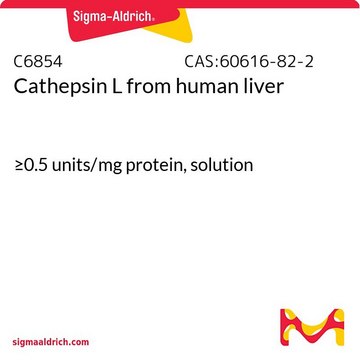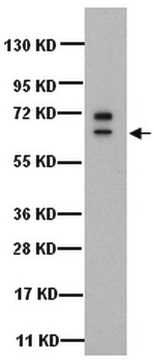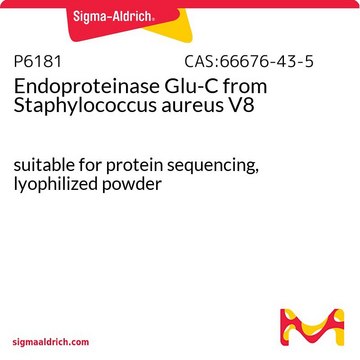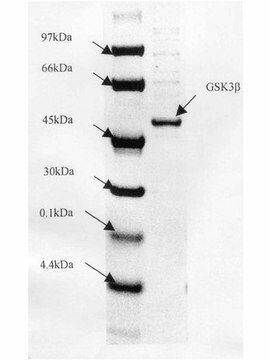219402
Cathepsin L, Human Liver
Cathepsin L, Human Liver, CAS 60616-82-2, is a native, the most potent of all the lysosomal proteinases. Plays a major role in the proteolysis of both cellular and endocytosed macromolecules.
別名:
CTSL, CTSL1, Human Cathepsin L, Major excreted protein (MEP)
ログイン組織・契約価格を表示する
すべての画像(1)
About This Item
おすすめの製品
由来生物
human liver
品質水準
詳細
Merck USA index - 14, 1905
フォーム
liquid
メーカー/製品名
Calbiochem®
保管条件
OK to freeze
avoid repeated freeze/thaw cycles
テクニック
activity assay: suitable
適合性
suitable for molecular biology
アプリケーション
life science and biopharma
輸送温度
wet ice
保管温度
−70°C
遺伝子情報
human ... CTSL(1514)
詳細
Research area: Cell Signaling
Cathepsin L, Human Liver, native, is the most potent of all the lysosomal proteinases. Cathepsin L (CTSL) belongs to the papain subfamily of cysteine proteases and is mainly located in endolysosomal vesicles.
Cathepsin L, Human Liver, native, is the most potent of all the lysosomal proteinases. Cathepsin L (CTSL) belongs to the papain subfamily of cysteine proteases and is mainly located in endolysosomal vesicles.
生物化学的/生理学的作用
Cathepsin L (CTSL) has higher activity than cathepsins B and H in the degradation of a variety of physiological protein substrates. It is believed to be responsible for the generation of endostatin from the NC1 domain in collagen XVII. It is responsible for regulating cell cycle, nucleotide-binding domain, leucine-rich–containing family, pyrin domain–containing-3 (NLRP3) inflammasome activation, proteolytic processing of Bid during apoptosis, and TGF-β signaling. It can degrade a wide range of proteins, encompassing enzymes, receptors, and transcription factors. Additionally, it produces active enzymes, receptors, and biologically active peptides through controlled proteolysis. Moreover, Cathepsin L has been observed to enhance tumor cell migration by lowering cell-cell adhesion and breaking down elements of the extracellular matrix. The expression of CTSL escalates in several types of cancers, including glioma, melanoma, pancreatic, prostate, and breast cancer. It plays a major role in the proteolysis of both cellular and endocytosed macromolecules.
包装
Please refer to vial label for lot-specific concentration.
警告
Toxicity: Standard Handling (A)
単位の定義
One unit is defined as the amount of enzyme that will hydrolyze 1.0 µmol of Z-FR-AFC per min at 25°C, pH 5.5.
物理的形状
In 400 mM NaCl, 20 mM malonate buffer, 1 mM EDTA, pH 5.5.
調製ノート
Prepared from tissue of individuals that have been shown by certified tests to be negative for HBsAg and for antibodies to HIV and HCV.
再構成
Following initial thaw, aliquot and freeze (-70°C).
その他情報
Note: 1 mU = 1 milliunit
法的情報
CALBIOCHEM is a registered trademark of Merck KGaA, Darmstadt, Germany
保管分類コード
12 - Non Combustible Liquids
WGK
WGK 2
適用法令
試験研究用途を考慮した関連法令を主に挙げております。化学物質以外については、一部の情報のみ提供しています。 製品を安全かつ合法的に使用することは、使用者の義務です。最新情報により修正される場合があります。WEBの反映には時間を要することがあるため、適宜SDSをご参照ください。
Jan Code
219402-25UG:
219402-UG:
試験成績書(COA)
製品のロット番号・バッチ番号を入力して、試験成績書(COA) を検索できます。ロット番号・バッチ番号は、製品ラベルに「Lot」または「Batch」に続いて記載されています。
ライフサイエンス、有機合成、材料科学、クロマトグラフィー、分析など、あらゆる分野の研究に経験のあるメンバーがおります。.
製品に関するお問い合わせはこちら(テクニカルサービス)








